Source: Northwest Indian Fisheries Commission
The Nisqually Tribe’s natural resources office has been recording their activities over the last few weeks using personally mounted cameras. Here’s your first look, this time at steelhead surveys.
syəcəb
Source: Northwest Indian Fisheries Commission
The Nisqually Tribe’s natural resources office has been recording their activities over the last few weeks using personally mounted cameras. Here’s your first look, this time at steelhead surveys.

Ashley Stewart, The Herald
Monster truckers, rodeo performers and musicians come from all over to be part of the Evergreen State Fair.
But it’s the community that sets the local gem apart.
“The entertainment is a lot of fun, but the quality of our exhibits — the barns, the animals, the quilts — that’s what makes us unique,” said Hal Gausman, manager of the Evergreen State Fairgrounds and Park.
“It’s just a big community party.”
And there will be no shortage of community at this year’s event.
Families will be blowing bubblegum, throwing Frisbees and eating pie.
Local 4-H and FFA animal exhibitors will show off dogs, llamas, cattle, pigs and piglets, and “the best collection of rabbits you’ll ever see anywhere,” Gausman said.
And they’ve added a robot-building section to the 4H exhibits.
Food vendors will serve elephant ears, purple cows, blooming onions and other, move adventurous foods.
“Basically, if you’re not afraid to eat almost anything, you can find it out here,” Gausman said.
He said visitors can expect interesting variations of popcorn this year.
Close to the food vendors is the family stage for visitors who didn’t get tickets to the fair’s grandstand stage entertainment. Jugglers, comic magicians and musicians will give free performances on the Pepsi Family Stage between the south end of the arena and the north end of the grandstand.
The fair offers three days of barrel racing, bull riding, steer wrestling and calf roping at the Pro West Rodeo and drag races, demolition derbies and other car events, available with tickets.
Familes can also cheer on squealing racers at the fair’s legendary all-Alaskan pig races, watch the saw-offs, log rolls, axe throws and spare pole climbs at the fair’s International Lumberjack Show and pick apples, gather eggs, dig for potatoes and milk a cow at the fair’s free Farmer for the Day spots.
“It’s just a great place to come out, spend the day and make memories,” Gausman said.
The Evergreen State Fair opened Thursday and continues through Sept. 2 at its Monroe fairgrounds, 14405 179th Ave. SE.
Regular gate admission $10 for adults, $7 for seniors and youth and free for ages 5 and younger or 90 and older.
Parking is $8 on weekdays, $10 on weekends. Season and half-season parking passes are available.
Tickets are available online or by calling 800-514-3849, ext. 2.
For more information, call 360-805-6700. For a complete schedule of events, go to www.evergreenfair.org.
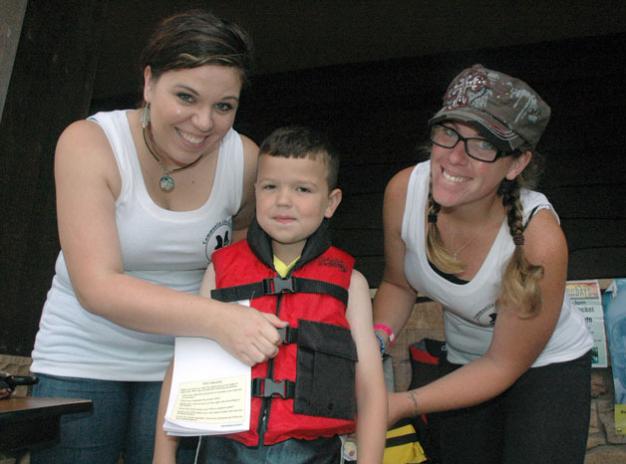
Kirk Boxleitner, Marysville Globe
MARYSVILLE — J.J. Edwards doesn’t want any other mother to suffer the loss she experienced when her 10-year-old stepson, Elijah Spratt, drowned on the Stillaguamish River on June 30.
After conducting lifejacket donation drives on July 6 and 13 at Twin Rivers Park in Arlington, where her stepson went into the water, Edwards and her friend Amy Jacobson partnered with the Tulalip Cabela’s to perform lifejacket fittings and serve up a benefit barbecue in front of the store on Saturday, Aug. 17, and Sunday, Aug. 18.
Jacobson explained that she and Edwards are trying to enter the Evergreen State Fair Aug. 22 through Sept. 2, to reach as many people as possible with their water safety message, but they need volunteers to help man their booth during those 12 days.
“At the Stillaguamish Festival of the River, we heard so many people say, ‘Oh, my kid can swim,’” Jacobson said.
“They don’t realize that the rush of the river is a little different from still waters,” Edwards said. “I get a little emotional over it.”
Katie Sanford, marketing manager for the Tulalip Cabela’s, sees Edwards and Jacobson’s mission as dovetailing with Cabela’s own goals of supporting its stores’ surrounding communities and helping people enjoy the outdoors safely.
“We sell boats and lifejackets, and promote being on the water,” said Sanford, who joined Edwards and Jacobson in praising Snohomish County Search and Rescue and the Everett Sail & Power Squadron for aiding their efforts. “When we saw this story in the newspaper, we were really touched by it, and we’re very glad to have such great partners for such a great cause.”
Edwards and Jacobson are providing updates on their campaign at www.facebook.com/TwinRiversPark-CommunityLifeJacketShed. For more information, or if you would like to contribute, log onto www.gofundme.com/3u01ho.
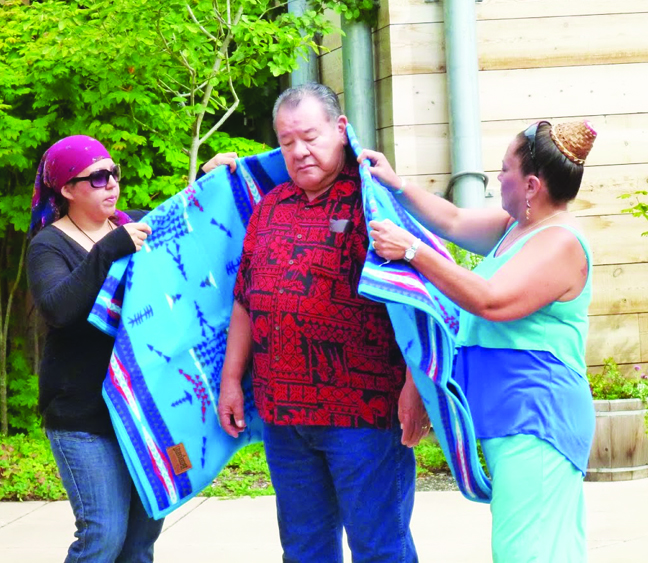
Donations to benefit the Natural History Preserve
By Andrew Gobin, Tulalip News
Tulalip − For the second year the Hibulb Cultural Center in Tulalip held an open house for the anniversary celebration Saturday, August 17th. After a 20 year dream, and more than ten years of planning, the long awaited museum opened in 2011. This year, the emphasis of the anniversary was funding the Hibulb natural history preserve.
“We are not a profit driven operation. In fact we make very little money. Most of the museum operations are funded from donations or through grants, instead of tribal hard dollars,” explained Mytyl Hernandez, Hibulb’s marketing and membership manager.
Attendees could wander through the vendors or sit in on any number of cultural seminars held throughout the day. The museum had items for sale in the seminars as well, and held a raffle for Hibulb merchandise.
The day’s events began by remembering the late Henry “Hank” Gobin, former museum director, who passed away earlier this year. The completion of Tulalip’s own natural history preserve was his dream since he began his work in revitalizing the culture at Tulalip.
For more information on the Hibulb Cultural Center visit www.hibulbculturalcenter.org.

By Andrew Gobin, Tulalip News
Students from the Tulalip Tribes Summer Youth Program spent the day in Finance Park at Junior Achievement World in Auburn, on Thursday, August 15th. The day at the park is the culmination of a two-week educational JA (Junior Achievement) camp at Tulalip. The camp is unique to the tribes as it targets what Tulalip students are calling their “18 money,” the trust fund per capita that the tribe sets aside for them until they graduate. The Tulalip camp focuses on the trust fund, and teaches how to make that money go further.
“Junior Achievement is actually a k-12 curriculum,” explains Gary Hauff, regional director for Junior Achievement. “Typically we go into schools and offer education programs for class credit. For the tribes, we are trying something different. The summer camp is unique to Tulalip, geared towards teaching personal finance responsibility and budgeting agendas.”
“At JA we work with the youth to plant the seeds of financial responsibility and stability,” added Sue Elkin, manager at JA World.
Finance Park is designed as a virtual city where students can practice being adults, and put into action what they learned at camp. Arriving at JA World, the students are given an identity complete with a salary, a family, pets, and a debit card. Students then buy or rent a house or apartment, purchase a car that adequately fit the demands of their virtual life, collect and pay their bills, and even make time for vacations. Along with projected costs, kids learn to deal with unexpected costs that arise in everyday life. Students tour the park, collecting bills and shopping, and making the dreaded stop at the chance station, where they draw cards that may result in an unlucky additional cost to their budget, such as taking their pet to the vet.
“We get a real look at life, and what the costs are,” said Bradley Fryberg. “Here [Finance Park] I make $48,000 a year, I have no kids, I’m single, 30, and have an apartment and a sports car.”
Some students juggled two or three kids and drove mini vans.
“Junior Achievement teaches us to be responsible with our money,” said Bryce Juneau Jr. who is planning on saving his trust money until after college.
Students learn about stocks and bonds, compound interest accounts, the risks associated with both of those, and the possible gains they offer.
“Just as life is multi-faceted, we at JA are diversifying,” explained Elkin. “We used to be strictly business oriented, then last year we started branching out into the sciences and other fields. This year we worked to incorporate art and music into the program.”

This included a little fun competition working with shoe designs and a special appearance by Native shoe designer Louie Gong.
Gong spoke to the students about his designs and the work it entails. He provided shoe forms called “mockups” for the kids to express their creative talent on. The shoes were then voted on and the student with the winning shoe design received tickets to a Mariners game.
Tulalip’s Israel Simpson designed the winning pair of shoes. “I just picked up the pens and kept going. Inspired from my auntie, always saying, draw what you feel.”
The camp encourages education, both in the completion of high school and in pursuing higher education. This is important, because many do not realize that should they not complete high school or get their G.E.D., they with not get their trust per capita until they are 21.
Many different post high school options are explained including trade schools, community colleges, universities, online degrees, and entrepreneurship.
Facility upgrades raise the survival rate

By Andrew Gobin, Tulalip News
Tulalip−Though marauding sea lions have been a constant nuisance to hatchery operations, it is now apparent they stand to threaten the success of hatchery runs as they have become more aggressive, pushing further upstream into holding areas for returning salmon. Through a series of upgrades to the facilities at the Bernie ‘Kai Kai’ Gobin Hatchery at Tulalip, changes are being made to optimize salmon returns.
Newly built sea lion fences at Battle Creek and below the hatchery dam and fish ladder prevent sea lions from going up stream, while allowing salmon to pass through.
“At low tide, the sea lions are belly-crawling up Battle Creek and taking females out of the holding area,” said Jesse Rude, hatchery assistant manager. “We can’t have a shortage of eggs, otherwise we have no fish to hatch.” Rude further noted that, “these fences are first of their kind. No other system like it is known to be used, or in existence.”
At the damn, a small pond with a barricade of rocks sits below the fish ladder, behind the new fence. This allows the salmon to get behind the fence where they are protected, while keeping the salmon from going upstream too early; another new technique the hatchery is trying. “Incidentally, this is good for the fishermen too, keeps the fish out in the bay to be caught,” noted Rude.
At the top of the ladder, a mechanized holding pen and fish lift are installed. The lift looks similar to a car elevator from a parking garage, and can lift comparable weight loads. This allows the salmon to be pulled out and processed more quickly than pitching fish by hand.
The last major upgrades were the installation of birdnetting, to keep birds from getting an easy meal in the lower ponds and creeks, and the new larger pond at the hatchery.
“With the larger pond, we are able to do a lot more Chinook,” said Rude, referring to larger quantities of eggs, and later smolt, that the pond can hold relative to the area needed to have a productive salmon hatch.
“Last year we hatched 1.5 million Coho, and we released a record 1.3 million fish.” Typically, the rate of survival is 50% to 60%; meaning only half of what is hatched actually gets released.
Ironically, the upgrades from 2005 and 2006 led to the record-breaking release of Coho. The snow built up on the birdnetting, breaking the nets and dragging the support posts, and the Jersey barriers that anchored them, into the fish ponds.
“We had to move all of the fish up to the new larger pond,” Rude explained. As a result, the Coho run was over-wintered, meaning they were more mature than normal when released.
They were free of predation back up in the pond as well. Rude said, “the otters are like rats in the ponds. They are everywhere and they eat the fish. The last couple of years we’ve had to hire predator control to manage the otters.”
When asked about the success of over-wintering and potential continuation, Rude said they would be trying similar methods with all of their runs this year.
Other upgrades include expanded feed and storage facilities, covered or shaded ponds, a concrete fish weir put in at Battle Creek, and expanding and repairing the birdnetting for all hatchery creeks and ponds.
By Mike Benbow, The Herald
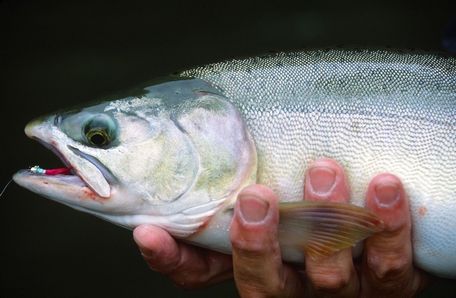
They’re expecting 6.2 million pink salmon to enter Puget Sound this year.
If you or a member of your family have always wanted to catch a salmon, now is your best chance.
The sheer numbers of pinks will up your odds of success either in the Sound or in the local rivers.
“A bumper crop of pink salmon always generates a huge response from anglers,” said John Long, statewide salmon manager for the Washington Department of Fish and Wildlife. “You can catch them from a boat, you can catch them from the shore and you can catch them throughout most of Puget Sound. It’s a great fishery for kids and whole families.”
If you’d like to make catching a pink a family project this year, here’s some information that might help. Fishing should be good now and for the next few weeks.
Where to go
More than any other salmon, pinks like to travel close to shore while heading to their home rivers, so fishing from the beach is an effective way to catch them in salt water, especially if you don’t have a boat.
Whether in a boat, on a beach, or on a river bank, look for pinks jumping and rolling as a sign of where to cast your lure or fly.
Salt water with boat: Humpy Hollow (south of Mukilteo) or Kayak Point (south of Stanwood).
Beaches: Bush Point (Whidbey Island), Picnic Point (Edmonds), Kayak Point (south of Stanwood).
Rivers: Stillaguamish, Snohomish, Skykomish. Tip: the fish are in better eating condition if you fish closer to salt water.
The Snohomish/Skykomish system is already open for pink fishing. The North Fork of the Stillaguamish is closed to salmon fishing, and the main stem of the Stillaguamish doesn’t open for pinks until Sept. 1.
Keeping pink salmon
Pinks deteriorate quickly, but they are good table fare if cared for properly.
After catching a pink, remove the gills and let the blood drain out of the fish. You can filet them later. Put on ice right away. Eat the fish in the next day or so.
Cooking pinks
Pinks are an oily fish, so they work well on the smoker. But they also can be tasty on the grill.
Fillet the salmon and add some lemon juice, fresh cracked pepper and some butter.
Cook on the grill at about 375 degrees for 18 to 20 minutes. Much of the oil will drip off the salmon onto the grill, adding a smoky taste.
Serve with lemon basil aioli: In a small bowl mix 1/4 cup of mayonnaise, 1 tablespoon of chopped fresh basil, 1 1/2 teaspoons of grated lemon zest, 2 teaspoons of fresh lemon juice, a small clove of minced garlic, and 1/4 teaspoon of kosher salt.
Pink marabou jig
I consider pink marabou jigs to be the most effective lure for pinks in both salt and fresh water. You fish them by jigging the rod up and down while reeling in your line, creating an erratic action that is often irresistible to fish.
You can buy them at most sporting goods stores, including John’s Sporting Goods, 1913 Broadway, Everett; Ted’s Sports Center, 15526 Highway 99, Lynnwood; and Cabelas, 9810 Quil Ceda Boulevard, Tulalip.
Jigs are also easy to make and the materials are available at the same locations. Here’s how:
Buy: 1/4-ounce lead-headed jigs, hot pink marabou feathers, hot pink thread, a thread bobbin, Sally Hansen’s Hard as Nails clear fingernail polish (available at any drug store).
You will also need a pair of sharp scissors and some sort of tying vise. Fly-tying vises are expensive, so you can use a regular woodworking vise in your workshop, pliers or vise grips if you’re just going to make a few.
1. Attach jig to vise.
2. Attach thread to jig collar by wrapping it over itself a few times.
3. Stroke tip of entire marabou feather and cut so it extends from the head of the jig to about 3/4 of an inch past bend of hook.
4. Tie cut end in at jig collar with several wraps of thread.
5. Repeat with two more feathers to cover entire collar of jig.
6. Wrap thread repeatedly over cut edge of feathers to produce a neat collar below jig head. Tie off thread with three half hitches and cut end with scissors.
7. Coat thread with nail polish and let dry.
Pink gear
Rods: Use a medium weight spinning rod or a 5- to – weight fly rod, either should be about 9 feet long.
Line: Line or leader material should be 8- to 12-pound test.
Lures: Pink Buzz Bombs, 2.5 inches long, or Rotators, or a 1/4-ounce pink marabou jig. Fly fishers can use pink clousers in the Sound and a pink woolley bugger in the river.
By the numbers
2 The lifespan in years of a pink salmon, which spawns in most Washington rivers in odd-numbered years.
3-5 The weight of a pink salmon in pounds. Pinks are the smallest of the five species of Pacific salmon.
18-24 The average length of pinks in inches.
409,700 The number of adult pinks expected to spawn in the Stillaguamish River this year based on a count of the young fry that left the river two years ago.
988,621 The number of pinks expected this year in the Snohomish River and its tributaries.
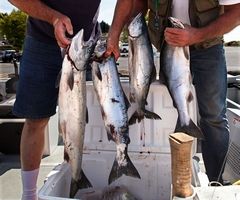
Bill Sheets, The Herald
EVERETT — Every odd-numbered year, visitors to local shorelines in late summer are often struck by the sight of an extraordinary number of small boats on the water.
They might also see people standing along the beach with fishing poles in their hands.
“Everyone hears the word ‘pink’ and they just want to come out and join the rat race,” fisherman Nigel Anders of Arlington said as he launched his boat in Mukilteo recently.
While some species of salmon and trout are struggling to survive — Puget Sound chinook and steelhead are both listed as threatened under the federal Endangered Species Act — pink salmon and other species are thriving or holding steady.
Every major species of Pacific salmon and trout can still be found in Snohomish County waters — chinook, coho, chum, pink and sockeye salmon, along with rainbow and cutthroat trout. A species of char, called a bull trout, is found here as well.
There’s also a large sturgeon population that visits Port Susan, near Stanwood, according to state fish biologists.
These fish are all anadromous, meaning they travel into streams to spawn, and spend the bulk of their lives in saltwater. The salmon, trout and char are part of the salmonid family.
“We have a lot of fish here and a lot of water,” said Justin Spinelli, a biologist for the state Department of Fish and Wildlife.
Each river, stream and lake has its own unique, colorful mix of fish. The Snohomish River, for example, is home to one of the largest coho populations on the West Coast, generally exceeded only by the Skagit River and the Columbia, said Mike Crewson, fisheries enhancement biologist for the Tulalip Tribes.
Sockeye salmon — a small, tasty variety — are best known in this area for their large runs in Lake Washington and its tributaries, some of which reach into Snohomish County. Baker Lake in the North Cascades has a large population, as well. But sockeye also are found, at least in small numbers, in most other local rivers, biologists say. A large population of landlocked sockeye, or kokanee, swim in Lake Stevens.
Sockeye turn bright red before spawning, earning them the nickname “red salmon.” Coho salmon are known as “silvers” for their clean, shiny look. Rainbow trout are aptly named, with their scales reflecting a multi-colored hue. Cutthroat trout are named for a red strip that runs along the underside of their heads behind their mouths.
Pink salmon are named for the color of their flesh. The smallest of the Pacific salmon, they’re also called “humpies” because their backs develop a prominent hump before spawning.
What pinks lack in size or flavor compared to other salmon species, they make up in numbers. More than 6 million humpies are forecast to return to rivers in the Puget Sound region this year. That’s well shy of the record of 9.8 million pinks set in 2009, but this year’s run is still on the high side, state wildlife officials say. State records go back to 1959.
Of those expected back this year, nearly 1 million pinks are forecast to head for the Snohomish River to spawn and 400,000 more are forecast to return to the Stillaguamish River. About 1.2 million are expected in the Skagit River
Pinks can be caught both in saltwater and in the rivers. Saltwater and the Snohomish River are open to pink salmon fishing now. The season opens in the Stillaguamish and remaining areas on Sept. 1.
Humpies have a shorter life cycle than other salmon, returning to spawn after two years. While most return in odd-numbered years, some do return in even-numbered, “off” years, Crewson said.
Pinks currently have a combination of advantages working for them over other salmon species, biologists say.
They can spawn in more places, do it more quickly, head straight for saltwater after hatching and spend less time there once they arrive.
This makes them less susceptible to the habitat destruction and changing ocean conditions that can push down survival rates of other species.
Humpies can spawn in the tiniest of streams, Crewson said.
“Pinks can go up anything that’s flowing,” he said.
Juvenile chinook and coho stay in fresh water and grow for up to a year and a half after they’re hatched before heading to sea. Pinks head out in a matter of days, biologists say. That helps pinks avoid the ravages of urban runoff, which can scour and pollute salmon-bearing streams.
In saltwater, the issues are more complex, but survival rates there have been on the decline, biologists say.
Fish depend on upwelling of plankton from the lower reaches of inland waters and the ocean. These organisms form the base of the food chain for salmon and trout.
These upwelling patterns have become more erratic, especially in the Puget Sound basin, biologists say, creating more of a hit-and-miss proposition for the fish.
The causes haven’t been nailed down, but climate change is believed to play a part, Crewson said. More rain and less snow falls in the mountains, creating more flooding. This can affect upwelling along with habitat, he said.
“Changes in stream-flow patterns can alter when plankton blooms happen and when fish go out,” Crewson said
Pink salmon have been hitting the plankton blooms better lately than the other fish, he said.
“An early outmigrating salmon has got an advantage,” Crewson said.
El Nino conditions, in which warmer water moves northward from the central Pacific, also can throw food chains out of whack, he said.
Seals and sea lions also are suspects in falling survival rates for salmon. Populations of the fish-eating mammals have been increasing in the Puget Sound area in recent years.
Trout, like larger salmon, require longer rearing periods in fresh water. Puget Sound-area steelhead — rainbow trout that go to sea — have been having trouble getting there, biologists say.
Some have been planted with electronic tags and can be counted when they run across any of several electronic beams sent across the water along Admiralty Inlet and the Strait of Juan de Fuca. Many are disappearing before they get to these points, biologists say. That means the steelhead aren’t heading out to the Pacific Ocean.
“There’s something drastically wrong when you lose that many fish,” Crewson said. “Our steelhead numbers (in the Snohomish basin) have been way down.”
The other primary trout species in the area, cutthroats, are holding steady, said Brett Barkdull, a state fish biologist based in La Conner.
Some of these trout stay in rivers, while those that venture into saltwater, known as sea-run cutthroat, don’t go as far afield as steelhead, Barkdull said. They tend to stay in bays and estuaries.
The sea-run cutthroats, while smaller than steelhead, are prized by many serious anglers for their fighting ability. They once were overfished, Barkdull said. In 1990, strict limits were placed on their harvest. Those regulations have helped the fish recover, but still in many areas now they are allowed to be caught but not kept, or may be kept only if they’re above a certain size.
Because of those rules, cutthroat trout tend to be overlooked by casual anglers, said John Martinis, owner of John’s Sporting Goods on Broadway in Everett.
“They’re a very, very popular fish among the fly fishermen,” he said.
Fish populations in the Skagit River are generally healthier than in the rivers in Snohomish County and others in urbanized Puget Sound, Barkdull said.
Many of the Skagit’s upstream waters are in North Cascades National Park or national forest land, he noted.
“I think part of that has to do with the fact that a lot of the rearing habitat is protected,” he said.
In general, numbers for all the fish in the Puget Sound region are down from historic levels, Crewson said. Some, like the pinks, are bouncing back, and that’s good news for people who like to fish.
“It’s one of those opportunities where novice anglers as well as experienced anglers can do really, really well,” Martinis said.
Learn more
For more information, visit the state Department of Fish and Wildlife’s information page on salmon and trout at http://tinyurl.com/ozu787a.
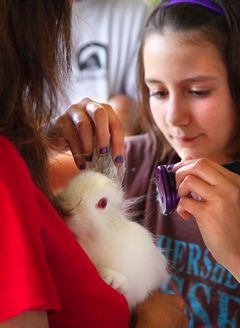
Source: The Herald
U.S. 2 heading into Monroe will start to clog up earlier in the day next week as the Evergreen State Fair gets rolling Thursday.
The fair begins at 10 a.m. Thursday and continues until through 7 p.m. Sept. 2 at the Monroe fairgrounds, 14405 179th Ave. SE, Monroe.
Admission is free until 1 p.m. on the first day of the fair.
After that, tickets are $10 general, $7 for senior citizens and youth and free to seniors 90 years and older and kids 5 years and under
Complete information on pricing and ticketing are at www.evergreenfair.org.
Grandstand entertainment will include monster trucks, stock car races and music.
The music schedule includes The Oak Ridge Boys at 7 p.m. Aug. 26 (tickets are $22 to $32); Brantley Gilbert at 7:30 p.m. Aug. 27 ($32 to $55); 3 Doors Down at 7:30 p.m. Aug. 28 ($32 to $55); REO Speedwagon, 7:30 p.m. Aug. 29 ($32 to $55); and Mercyme, 7:30 p.m. Aug. 30 ($25 to $37).
Tickets are available at www.evergreenfair.org.
The fair has always been the showcase for 4-H and FFA animal exhibitors, showing off cattle, dogs, rabbits, sheep and llamas. Kids will also exhibit their areas of expertise in photography, plant and soil science, veterinary science, home economics and herdsmanship.
This year the Monroe Chamber of Commerce has created Parade Central, on the grounds of Wagner Performing Arts Center, 639 West Main St., Monroe.
Parade Central is the new location for the judges’ reviewing stand, vendor booths, shaved ice, face painting, kettle corn and Monroe-based Hook-n-Ladder BBQ.
These vendors will be at Parade Central to serve the crowds who show up early to get a good seat for the parade.
The route begins at 11 a.m. at the intersection of West Main Street and 179th Avenue on Aug. 24 and ends at West Main Street and Blakely Avenue. For more parade information go to www.ChooseMonroe.com or call the Monroe Chamber at 360-794-5488 or stop by the office, 125 S Lewis S., Monroe.
Highlights of this year’s parade include the Seahawk Sea Gals cheerleaders, the SeaFair Pirates, drift and drag cars from the Evergreen Speedway, the Pirates of Treasure Island, Ixtapa Horses, local bands, drill teams, and tractor and motorcycle clubs, according to a chamber press release.
Bleachers are being brought into Parade Central to accommodate parade viewers and participants near the judges’ reviewing stand.
Butler Amusement will again provide the carnival rides.

Source: The Herald
Folk rock musician Melissa Etheridge will perform Sunday at the Tulalip Amphitheatre.
Etheridge released her debut, self-titled album in 1988, but gained fame withher fourth album “Yes I Am” in 1993, including hits “I’m the Only One” and “Come to My Window.”
She is also a notable activist for gay and lesbian rights.
The show starts at 7 p.m., doors open at 5 p.m.
You must be 21 or older to attend. Tickets start at $25, available at www.ticketmaster.com.
Next up is Foreigner on Aug. 25 and the Doobie Brothers and America on Sept. 7.
Tickets start at $30 for these shows.
The amphitheatre is at 10400 Quil Ceda Blvd. Tulalip.
For more information, visit www.tulalipamphitheatre.com.